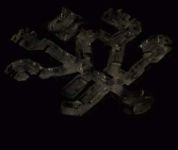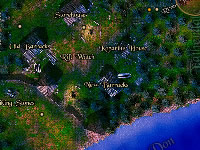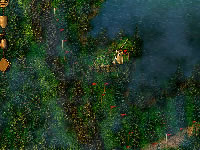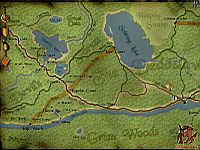|
|
|
Main News Forums Games Games Database Top 100 Release List Support Files Features Reviews Previews Interviews Editorials Diaries Misc Download Gallery Music Screenshots Videos Miscellaneous Staff Members Privacy Statement |
Fatherdale Development Diary, part 3 Sergei Klimov, 2001-07-05
Sergei Klimov, lead designer for Fatherdale gives us his views on things with this series of development diaries. In thid third part he explains that making a game is not only about adding features but also about not adding or removing them. Accompanying the article are three images of different types of maps that are in the game and have had some changes since the beginning of the development also.
"JOSE immediately rolls over and feigns sleep as SCARFACE, a menacing male guard in his mid-twenties, heavy beyond his years and most probably either a willing participant or a suffering victim of genetic improvement, with a square chin and a jagged scar running down his cheek, wearing bright orange uniform, four spare loads of ammo hanging at his belt, metallic shoes placed squarely on the wet floor reflecting the light from bright neon lamps hanging above and burning in different shades as though a mosaic arranged by some madman whose playing field stretches to cover the whole cell, looms close to COLE's cage and unlocks it." The above was originally a part of the script for "Twelve Monkeys", but then got overused by me as I added too many details to the guard's description. This was a dire attempt to explain the point of this issue right ahead: as Americans from the Mid-West would say, "can't have it all". Back when I was only starting to work on Fatherdale, we've spent about two years trying to add to the project all the nice things we wanted from what we then called "a perfect game" - and how could I have imagined that the next two years we would actually spend removing a lot of these concepts in order to make the game playable for the public? As the example of Red Lemon's Braveheart once proved, there really could be such a thing as too many features. When we say that our game is based in XI century, players - and often publishers - would immediately retell their priorities. Take, for example, the question of inventory items... "We want to have a really good trading system - should be easy, and wasn't it based on the pure exchange back in those ages?" In a lot of cases, it was. And how cool would it be to have a trading post along the Viking road, and a trading caravan in the steppe, and a trading village in the forest so that you could have turned in all the items that you picked up? Just like in the Silmarilis' old space travel title, you could use the chance to buy cheap sabres from the Khan and exchange them with profit for, say, hunting arrowheads in the forest, only to trade those for an excellent shield at Vikings' place. "We want to have a balanced repair system where you could give your damaged stuff to the blacksmiths - and could you also foresee a way to improve your inventory items this way?" Now, this sounds like an excellent idea - say, an inventory item could be repaired by its owner up to 80% as long as it wasn't damaged below 60%, while to repair it completely - or to mend the ones broken below these 60% -- you would have to go to the blacksmith proper. Then, some blacksmiths would be skillful enough to actually improve items, increasing their attributes. Get a cheap battle axe with poor balance and use your good relationship with the chief blacksmith to upgrade it, making it a weapon of mark and a valuable trade item. "Because you play for a warlord, doesn't it mean he has full access to prince's garrison and all the weapons of the Valley - and could you also let him chose from the selection of those to properly fit his party?" I'd say, coming to a garrison with ten of your people after a long and tiresome fight to lay down the swords and pick up some long-range bows, with which later that night you could make an awesome ambush on the main road of Vikings sounds like fun. And why not, since historically a warlord had full access to the weaponry and could order to garrison's blacksmiths - some of the best around - whatever he needed, whether a modification or a completely new item.
And so it goes on, and on, and on... However, if you manage to build an RPG/Adventure with all of the above fully functioning, I can't see how you would have any time left for the other parts of the gameplay - not to mention balancing things like trade based on unique items and a garrison full of weapons. For example, if we leave the trading system, in order to survive and progress in that game world you'd be spending a lot of playing time going between already known and familiar locations, trying to maximize trade opportunities... While I'd rather limit acquisition of new items to combat encounters and important quests, using the resulting free time to send players on exciting quests and challenges. There was a moment when Fatherdale's alpha had not only tactical, strategic, inventory, dialogue and quest interfaces, but also a building one (to construct new outposts), a trading one (to gain extra advantage by using demand and supply) and a political one (to manage diplomatic options with your neighbors). Luckily for us, after some testing we understood that we had borne a monster :). To sum it up, if there's something I understand now better than back when we started designing Fatherdale, it's that a good game is a consistent one and there's only so much that you can do at one time. Past certain stage, development is not really about doing new things as it is about polishing, balancing and focusing the gameplay on the aspects you've chosen as your core values.
The first dialogues I've written for Reinar, the immortal hero of our game, had several options for every key point and we all enjoyed the possibility to play in whatever style we wanted - I could be rude or polite, mysterious or down-to-earth simple, bragging or humble. However, somewhere along the way we've lost Reinar's personality, and as an adventure Fatherdale became less appealing - with so many possibilities to allow, there was too little of hero's character that you could keep together. It was a good RPG, but the storyline fell apart - and I'm not ready to give it up, really. The choice was obvious as it seems from here and at this moment in time, yet we went a long road of doubts and it took quite a courage to clearly acknowledge that Fatherdale is not only about what is there, but almost just as much about what isn't. In games, like in the piece of the misused script above, you can't really have it all and quite often the development is about making choices between one right option and another one that is equally right. Yes, you would lose a part of the audience. Yes, some press people won't be too happy to find your idea of a medieval RPG so different from their own expectations. Yet at the end of the day, the players that dare to enter your game would find it a consistent world laid out in a consistent gameplay pattern - a little something that's accomplished as opposed to a grand lot of possibilities that end up in confusion. In every good chorus, when the soloist sings, the rest must keep in the background. Ah, but alas - the time has ran out for today! I hope you had some insights from the little thing above and we will meet here again in two weeks from now with a new issue (or so I have promised to mighty Mythos :-).
Sergei Klimov
|
|||||||
|
All original content of this site is copyrighted by RPGWatch. Copying or reproducing of any part of this site is strictly prohibited. Taking anything from this site without authorisation will be considered stealing and we'll be forced to visit you and jump on your legs until you give it back. |
||







